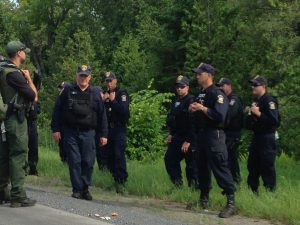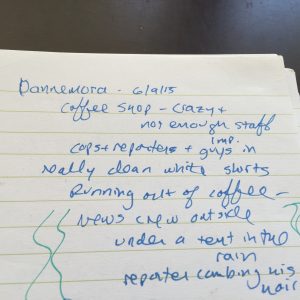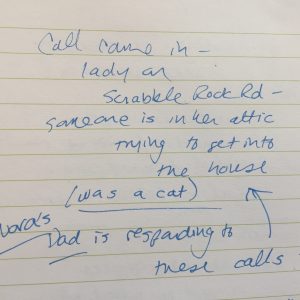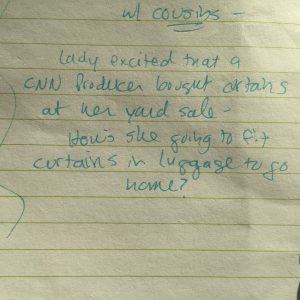Countdown to Breakout is a 23-day blog series about the three-year writing process for BREAKOUT, which earned starred reviews from both School Library Journal and Publishers Weekly. It’s about a small-town prison break and manhunt that change the way three kids see their neighbors and the place they call home. Why a 23-day series? Because this book was inspired by the 2015 Clinton Correctional Facility prison break that led to a 23-day manhunt in June of 2015.
Collecting real-world details for a fictional setting
When I started working on BREAKOUT, I knew that my book was going to be fictional – about a made-up prison break in a made-up town that I named Wolf Creek, NY. But fictional settings need to be grounded with real-world details, and I spent my days in Dannemora collecting all sorts of notes that I knew I might use as I was building the town of Wolf Creek.
Each day as I drove into town, I’d see how the manhunt had changed a usually quiet place into a community buzzing with police activity. I took notes, not just on what I observed but on how I thought it would look and feel from the perspective of a middle school student who was excited about the end of school before all this happened.


This meant collecting not only details about the manhunt but details about everyday life in a small mountain town, too. In those three days I spent at the market and coffee shop near the prison, I made it a point to notice things. How the best sellers in the deli case were hot dogs and macaroni salad. How people from out of town were the only ones who bought the Adirondack Moose t-shirts. How the lady behind the counter couldn’t really keep up with slicing all the tomatoes they needed for subs and looked like she was ready to cross tomatoes right off the list of options.

I also paid attention to how the prison break affected that one small market in particular – how the manager had the police scanner turned on while she made subs, and how she paused every time there was a report that someone thought they may have spotted the inmates at the ice cream stand or worried that the escapees had broken into their attic.

Also…it was community garage sale day while all this was happening. One lady came in so excited that a CNN producer in town for the prison break had bought curtains at her yard sale. I jotted that down in case it was a detail I might want to use later.

Writers are expert eavesdroppers. And listening to the conversations of a place can be so helpful when you’re working to ground a fictional place in those specific, tiny details that make it feel real.
There were more settings and perspectives I needed to explore, and tomorrow I’ll talk about how a school visit helped with that. But for now, here’s your prompt of the day:
Your assignment: Go somewhere with your notebook – a coffee shop or diner or a kids’ soccer game. Collect as many tiny, unexpected details as you can. What kind of shoes is your waitress wearing? Does he have a quirky way of talking or a funny way she greets everyone? What are the kids who aren’t in the game doing over there on the bench? And listen in, too – what snippets of conversation can you collect?
Thanks for joining me on this part of the Breakout writing-process journey! If you’d like to read the other posts in this series once they’re all posted, you can find them here.

Buy BREAKOUT now:
- IndieBound (find a local bookseller near you!)
- The Bookstore Plus, Lake Placid, NY
- Powells
- Barnes and Noble
- Amazon





Thank you for sharing these insights into your writing process, Kate! They are so helpful for writers of all ages! Can’t wait to read the book!
fyi… NYT book review May 13 of “The Mars Room” ” ..It’s not giving away too much to say that, like most good prison novels, this one ends with an escape. There are two, actually, one clearly based on Richard Matt and David Sweat’s 2015 breakout in upstate New York. “
This is a really cool method of world building in writing that I do myself. I always try to pick up on mannerisms of certain people and try to figure out what makes them have these mannerisms, so when I’m writing them as characters, they can feel real and the reader can feel like they’re witnessing a geniune human interaction. Really interesting read, and I can’t wait for your book!